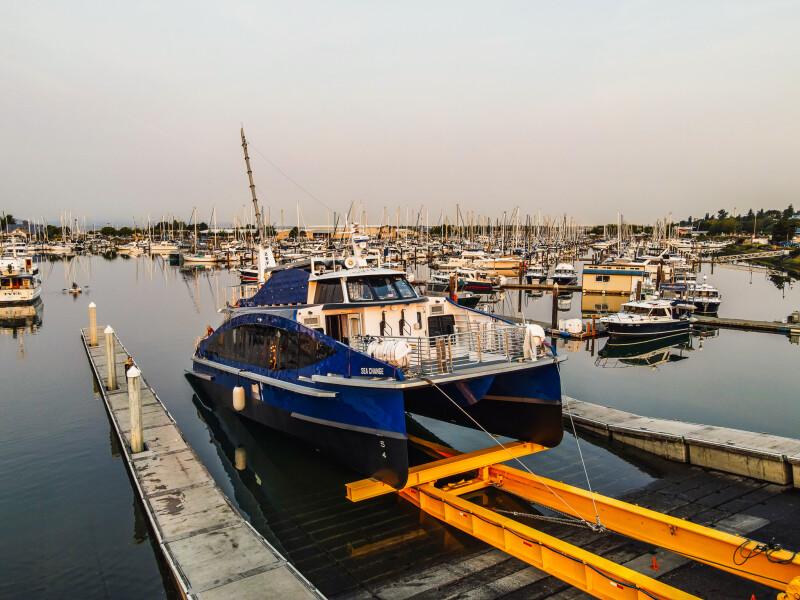All American Marine Inc. (AAM) and the vessel owner SWITCH Maritime have launched and completed operational trials of Sea Change, a 70', 75-passenger zero-emissions, hydrogen fuel cell-powered, electric-drive ferry that will operate in the California Bay Area.
Sea Change will be the first hydrogen fuel cell vessel in the U.S., representing a monumental step in the U.S. maritime industry’s transition to a sustainable future. The ferry was developed and constructed to demonstrate a pathway to commercialization for zero-emission hydrogen fuel cell marine technologies. While still working on permitting of hydrogen fuel systems for maritime vessels with the Coast Guard, the completed ferry will exhibit the viability of this zero-carbon ship propulsion technology for the commercial and regulatory communities.
The vessel is equipped with a hydrogen fuel cell power package provided by Zero Emissions Industries (formerly Golden Gate Zero Emission Marine), comprised of 360 kW of Cummins fuel cells and Hexagon hydrogen storage tanks with a capacity of 246 kg. The system is integrated with 100 kWh of lithium-ion battery provided by XALT and two 300 kW electric propulsion systems provided by BAE Systems. The hydrogen fuel cell powertrain system affords the same operational flexibility as diesel with zero emissions and less maintenance. The vessel design originates from Incat Crowther, and the construction supervision and management is led by Hornblower Group.
The project is funded by private capital from SWITCH, an impact investment platform building the first fleet of exclusively zero-carbon maritime vessels to accelerate the decarbonization and energy transition of the U.S. maritime sector. “By working closely with the U.S. Coast Guard, with innovative technology partners, and with best-in-class shipyards such as All American Marine, we can make the transition to decarbonized shipping a reality today,” Pace Ralli, co-founder and CEO of SWITCH, said in a prepared statement. “We don’t have to wait.”
SWITCH’s mission-driven platform seeks to work with existing ferry owners and operators around the country to help facilitate their adoption of zero-carbon vessels to replace aging diesel-powered vessels, leveraging significant experience from the technologies used in the build of this first ferry.
“Hydrogen-fuel cell technology will prove to be a robust alternative to conventional powertrain technologies,” said Ron Wille, AAM president & COO. “AAM is continuing our tradition of building vessels on the leading edge of technology using advanced propulsion methods, which is why we are so proud to have completed construction on such a revolutionary vessel.”
The project has received important municipal support including a $3 million grant from the California Air Resources Board (CARB), administered by the Bay Area Air Quality Management District (BAAQMD), that comes from California Climate Investments, a California statewide initiative that puts billions of Cap-and-Trade dollars to work to reduce greenhouse gas emissions, strengthen the economy, and improve public health and the environment — particularly in disadvantaged communities.
Additionally, the project received the first ever loan guarantee under BAAQMD’s Climate Tech Finance program, which seeks to reduce greenhouse gases by accelerating emerging climate technologies. In partnership with the California Infrastructure Economic Development Bank and the Northern California Financial Development Corporation (NorCal FDC), the Climate Tech Finance team led a technology qualification and greenhouse gas analysis that deemed SWITCH eligible for a loan guarantee. The loan supported SWITCH in securing a $5 million construction and term loan with KeyBank.
The Coast Guard Marine Safety Center (MSC), USCG Office of Design and Engineering Standards (CG-ENG), USCG Sector Seattle, USCG Sector San Francisco continue to support the permitting and development of sustainable maritime technologies that put the U.S. maritime sector at the forefront of global innovation.




